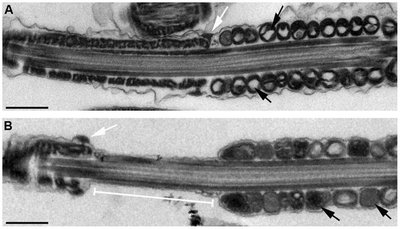SLIRP gene affects male fertility
Researchers have found that the SLIRP gene - discovered at the Western Australian Institute for Medical Research (WAIMR) and known to affect hormone action in breast and prostate cancer cells - has an impact on male fertility.
University of Western Australia (UWA) Winthrop Professor Peter Leedman said the research team found that when knockout mice (generated to have the SLIRP gene inoperative) were bred with wild type female mice, they produced 30% fewer offspring than normal mice and significantly fewer sperm which could be described as ‘good swimmers’.

doi: 10.1371/journal.pone.0070700.g004
These sperm were analysed through electron microscopy and found to have a disruption in the middle section of their structure, which was associated with their slow speed.

doi: 10.1371/journal.pone.0070700.g005
The research has increased our understanding of the role of the SLIRP gene, which could have ramifications for couples experiencing infertility. Infertility affects approximately one in eight couples globally - in half these cases the cause is attributable to the male partner - yet the exact cause in each case is often unclear. If human studies reveal that reduced SLIRP production is an important cause of infertility, assessment of SLIRP gene levels in male sperm could help explain why some couples are unable to have a baby - and help them find an alternative method before it’s too late.
“For example,” said Professor Leedman, “if our studies in men with infertility demonstrate a key role for SLIRP, then it is feasible that SLIRP testing could help streamline treatment options, eg, going more directly to IVF treatment rather than continuing to try conceiving without medical intervention for another six to 12 months.
“Hopefully, this might reduce some of the pain and anxiety experienced by these couples.”
The research by WAIMR and its collaborators has been published in the online journal PLOS ONE.
Blood test could be used to diagnose Parkinson's earlier
Researchers have developed a new method that requires only a blood draw, offering a non-invasive...
Cord blood test could predict a baby's risk of type 2 diabetes
By analysing the DNA in cord blood from babies born to mothers with gestational diabetes,...
DNA analysis device built with a basic 3D printer
The Do-It-Yourself Nucleic Acid Fluorometer, or DIYNAFLUOR, is a portable device that measures...







